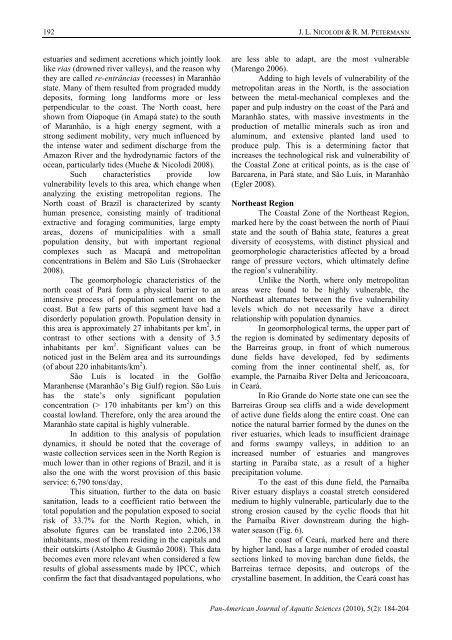Download full issue - PanamJAS
Download full issue - PanamJAS
Download full issue - PanamJAS
- No tags were found...
You also want an ePaper? Increase the reach of your titles
YUMPU automatically turns print PDFs into web optimized ePapers that Google loves.
192J. L. NICOLODI & R. M. PETERMANNestuaries and sediment accretions which jointly looklike rias (drowned river valleys), and the reason whythey are called re-entrâncias (recesses) in Maranhãostate. Many of them resulted from prograded muddydeposits, forming long landforms more or lessperpendicular to the coast. The North coast, hereshown from Oiapoque (in Amapá state) to the southof Maranhão, is a high energy segment, with astrong sediment mobility, very much influenced bythe intense water and sediment discharge from theAmazon River and the hydrodynamic factors of theocean, particularly tides (Muehe & Nicolodi 2008).Such characteristics provide lowvulnerability levels to this area, which change whenanalyzing the existing metropolitan regions. TheNorth coast of Brazil is characterized by scantyhuman presence, consisting mainly of traditionalextractive and foraging communities, large emptyareas, dozens of municipalities with a smallpopulation density, but with important regionalcomplexes such as Macapá and metropolitanconcentrations in Belém and São Luís (Strohaecker2008).The geomorphologic characteristics of thenorth coast of Pará form a physical barrier to anintensive process of population settlement on thecoast. But a few parts of this segment have had adisorderly population growth. Population density inthis area is approximately 27 inhabitants per km 2 , incontrast to other sections with a density of 3.5inhabitants per km 2 . Significant values can benoticed just in the Belém area and its surroundings(of about 220 inhabitants/km 2 ).São Luís is located in the GolfãoMaranhense (Maranhão’s Big Gulf) region. São Luíshas the state’s only significant populationconcentration (> 170 inhabitants per km 2 ) on thiscoastal lowland. Therefore, only the area around theMaranhão state capital is highly vulnerable.In addition to this analysis of populationdynamics, it should be noted that the coverage ofwaste collection services seen in the North Region ismuch lower than in other regions of Brazil, and it isalso the one with the worst provision of this basicservice: 6,790 tons/day.This situation, further to the data on basicsanitation, leads to a coefficient ratio between thetotal population and the population exposed to socialrisk of 33.7% for the North Region, which, inabsolute figures can be translated into 2.206,138inhabitants, most of them residing in the capitals andtheir outskirts (Astolpho & Gusmão 2008). This databecomes even more relevant when considered a fewresults of global assessments made by IPCC, whichconfirm the fact that disadvantaged populations, whoare less able to adapt, are the most vulnerable(Marengo 2006).Adding to high levels of vulnerability of themetropolitan areas in the North, is the associationbetween the metal-mechanical complexes and thepaper and pulp industry on the coast of the Pará andMaranhão states, with massive investments in theproduction of metallic minerals such as iron andaluminum, and extensive planted land used toproduce pulp. This is a determining factor thatincreases the technological risk and vulnerability ofthe Coastal Zone at critical points, as is the case ofBarcarena, in Pará state, and São Luís, in Maranhão(Egler 2008).Northeast RegionThe Coastal Zone of the Northeast Region,marked here by the coast between the north of Piauístate and the south of Bahia state, features a greatdiversity of ecosystems, with distinct physical andgeomorphologic characteristics affected by a broadrange of pressure vectors, which ultimately definethe region’s vulnerability.Unlike the North, where only metropolitanareas were found to be highly vulnerable, theNortheast alternates between the five vulnerabilitylevels which do not necessarily have a directrelationship with population dynamics.In geomorphological terms, the upper part ofthe region is dominated by sedimentary deposits ofthe Barreiras group, in front of which numerousdune fields have developed, fed by sedimentscoming from the inner continental shelf, as, forexample, the Parnaíba River Delta and Jericoacoara,in Ceará.In Rio Grande do Norte state one can see theBarreiras Group sea cliffs and a wide developmentof active dune fields along the entire coast. One cannotice the natural barrier formed by the dunes on theriver estuaries, which leads to insufficient drainageand forms swampy valleys, in addition to anincreased number of estuaries and mangrovesstarting in Paraíba state, as a result of a higherprecipitation volume.To the east of this dune field, the ParnaíbaRiver estuary displays a coastal stretch consideredmedium to highly vulnerable, particularly due to thestrong erosion caused by the cyclic floods that hitthe Parnaíba River downstream during the highwaterseason (Fig. 6).The coast of Ceará, marked here and thereby higher land, has a large number of eroded coastalsections linked to moving barchan dune fields, theBarreiras terrace deposits, and outcrops of thecrystalline basement. In addition, the Ceará coast hasPan-American Journal of Aquatic Sciences (2010), 5(2): 184-204
















